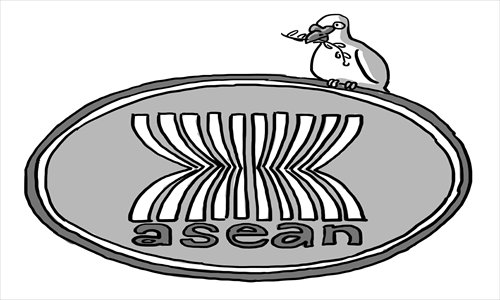ASEAN plays positive role amid sea spats

Southeast Asia has seen its fair share of happenings in recent months, ranging from the maritime incidents in the South China Sea to the recurring haze problems affecting some ASEAN members.
Moreover, the much vaunted ASEAN Economic Community (AEC), which is supposed to mold ASEAN into a single market and production base, is scheduled to go into effect but two years from now in 2015.
It was against these eventful backdrops that the 46th ASEAN Foreign Ministers Meeting took place recently in Brunei Darussalam, followed by the expanded ASEAN Regional Forum (ARF) attended by the foreign ministers of many other ASEAN partner countries.
The ASEAN foreign ministers essentially recalled the so-called ASEAN Way as enshrined in the Treaty of Amity and Cooperation in Southeast Asia. Some of the more salient points of the "ASEAN Way" include mutual respect for sovereignty, and settlements of differences and disputes in a peaceful manner.
To put the "ASEAN Way" into action, the ASEAN foreign ministers set forth two concrete steps: to begin publishing an annual ASEAN Security Outlook for enhancing transparency in the sensitive security field, and to set up an ASEAN Institute for Peace and Reconciliation for research into conflict management and resolution.
On the South China Sea, the ASEAN foreign ministers called for dialogues and trust- and confidence-building initiatives, and stressed the importance of stability and security in the region.
They also renewed their desire to continue ASEAN's engagement with China on the effective implementation of the Declaration on the Conduct of Parties in the South China Sea. But perhaps most significantly, the foreign ministers looked forward to impending formal consultations with China on the adoption of a Code of Conduct in the South China Sea.
These cordial sentiments were perhaps unfortunately overshadowed by an unexpected press release by the Philippine Department of Foreign Affairs, which expressed concerns over the alleged "increasing militarization" of the South China Sea.
Later, Philippine Foreign Secretary Albert del Rosario referred specifically to the presence of Chinese military and paramilitary ships in Huangyan Island and Ren'ai Reef (known as Scarborough Shoal and Second Thomas Reef in the Philippines).
Chinese Foreign Minister Wang Yi, who attended the ensuing ARF, made his rebuttal to the Philippine positions, and stressed that both his country and other coastal states are making efforts toward a stable South China Sea, and that contrary moves by individual claimant countries would not enjoy majority support and would not succeed.
At first glance, it would appear that the territorial dispute between China and the Philippines in the South China Sea has once again escalated, at least diplomatically. Upon closer examination, that gloomy scenario is manifestly and fortunately not the case.
In his speech, Wang Yi actually laid out very specific suggestions for maritime cooperation between China and ASEAN countries, including the good use of the China-ASEAN Maritime Cooperation Fund. He also called for the stepping up of Sino-ASEAN cooperation in defense and security, for common, collective and cooperative security.
All these can and should be construed as China's calls for peace, particularly in the South China Sea.
Rosario, in turn, when speaking to reporters, also disfavored the use of force in resolving the Philippines' territorial disputes with China.
It can thus be argued that although both sides spoke on "different wavelengths" during the recent Brunei meetings, both China and the Philippines were implicitly assuring their regional friends that armed conflicts were perhaps the last thing on their respective minds.
In addition, a more comprehensive regional picture also looms large in the background.
China is a major trading partner of ASEAN and vice versa.
In these economically challenging times, ASEAN countries, including the Philippines, could make good use of Chinese trade and investments.
Conversely, raw materials and natural resources from ASEAN countries are also indispensable to China's rapid national development.
As such, China and the Philippines, and indeed other ASEAN countries, should carefully weigh their overall relationships with each other, and set their respective domestic priorities right.
Both sides should refrain from provocative acts which would be detrimental to this sort of cordial and symbiotic international relationship.
The ASEAN Foreign Ministers Meeting and ARF inadvertently provided some parties to the South China Sea disputes an opportunity to vent their views, which might at times be diagonally different from one another.
But even in such an unforeseen scenario, ASEAN was actually playing its traditional role of gathering its collective wisdom and summoning its famous collegiality for enhancing the peace, security and development for the region.
The author is a senior fellow with the S. Rajaratnam School of International Studies, Nanyang Technological University, Singapore. opinion@globaltimes.com.cn